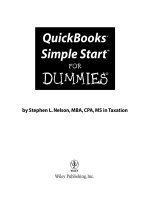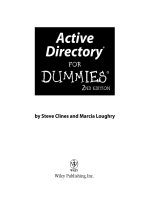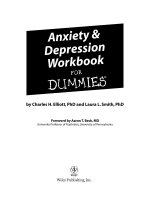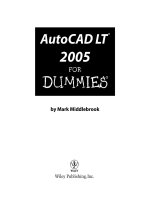quickbooks 2010 all-in-one for dummies (isbn - 047050837x)
Bạn đang xem bản rút gọn của tài liệu. Xem và tải ngay bản đầy đủ của tài liệu tại đây (25.82 MB, 627 trang )
Stephen L. Nelson,
MBA, CPA
8
IN
1
BOOKS
BOOKS
• An Accounting Primer
• Getting Ready to Use QuickBooks
• Bookkeeping Chores
• Accounting Chores
• Financial Management
• Business Plans
• Care and Maintenance
• Additional Business Resources
QuickBooks
®
2010
ALL-IN-ONE
Making Everything Easier!
™
Open the book and find:
• How to read a financial statement
• Steps for tracking accounts
receivable and payable
• Tips for managing cash and bank
accounts
• How to set up lists of customers,
vendors, and payroll items
• How to produce common financial
statements and reports
• What you can learn from ratio
analysis
• How to create and use a business
plan workbook
• Ways to simplify tax preparation
Stephen L. Nelson, MBA, CPA, provides accounting, business advisory,
tax planning, and tax preparation services to small businesses. He belongs
to both the Washington Society of CPAs and the American Institute of
CPAs, and he has written more than 100 books that have sold over four
million copies.
$34.99 US / $41.99 CN / £24.99 UK
ISBN 978-0-470-50837-4
Computers/Financial Applications
Go to Dummies.com
®
for videos, step-by-step examples,
how-to articles, or to shop!
Your one-stop guide
to managing your
business finances
QuickBooks is the leading small-business accounting
software, but there’s a lot to it. This guide makes it simple,
with individual minibooks covering different aspects of
QuickBooks, along with some basic business financial
management tips and pointers. Put them together, and
you will find that the business of running your business just
got easier!
• Accounting 101 — get a handle on accounting principles and
double-entry bookkeeping
• Starting out right — set up and fine-tune QuickBooks for your
business
• Keeping the books — become familiar with the procedures for
invoicing customers, paying vendors, tracking inventory, and
paying employees
• Day-to-day accounting — learn to prepare budgets, financial
statements, reports, and job-costing systems
• Managing finances — discover ratio analysis, economic value-
added analysis, and capital budgeting techniques
• Plan for success — get direction for writing a business plan and
using profit-volume-cost analysis
• Be prepared — protect your vital business data and troubleshoot
potential QuickBooks problems
• Find support — explore online business resources and learn
financial terminology
An Accounting Primer
Getting Ready to Use
QuickBooks
Bookkeeping Chores
Accounting Chores
Financial Management
Business Plans
Care and Maintenance
Additional Business
Resources
QuickBooks
®
2010
ALL-IN-ONE
Nelson
spine=1.25”
spine=1.25”
Start with FREE Cheat Sheets
Cheat Sheets include
• Checklists
• Charts
• Common Instructions
• And Other Good Stuff!
Get Smart at Dummies.com
Dummies.com makes your life easier with 1,000s
of answers on everything from removing wallpaper
to using the latest version of Windows.
Check out our
• Videos
• Illustrated Articles
• Step-by-Step Instructions
Plus, each month you can win valuable prizes by entering
our Dummies.com sweepstakes. *
Want a weekly dose of Dummies? Sign up for Newsletters on
• Digital Photography
• Microsoft Windows & Office
• Personal Finance & Investing
• Health & Wellness
• Computing, iPods & Cell Phones
• eBay
• Internet
• Food, Home & Garden
Find out “HOW” at Dummies.com
*Sweepstakes not currently available in all countries; visit Dummies.com for official rules.
Get More and Do More at Dummies.com
®
To access the Cheat Sheet created specifically for this book, go to
www.dummies.com/cheatsheet/quickbooks2010aio
QuickBooks
®
2010
A L L - I N - O N E
FOR
DUMmIES
‰
Contents
About the Author v
Dedication vii
Acknowledgments vii
MBA, CPA
QuickBooks
®
2010
A L L - I N - O N E
FOR
DUMmIES
‰
QuickBooks
®
2010 All-in-One For Dummies
®
Published by
Wiley Publishing, Inc.
111 River Street
Hoboken, NJ 07030-5774
www.wiley.com
Copyright © 2010 by Wiley Publishing, Inc., Indianapolis, Indiana
Published by Wiley Publishing, Inc., Indianapolis, Indiana
Published simultaneously in Canada
No part of this publication may be reproduced, stored in a retrieval system or transmitted in any form or
by any means, electronic, mechanical, photocopying, recording, scanning or otherwise, except as permit-
ted under Sections 107 or 108 of the 1976 United States Copyright Act, without either the prior written
permission of the Publisher, or authorization through payment of the appropriate per-copy fee to the
Copyright Clearance Center, 222 Rosewood Drive, Danvers, MA 01923, (978) 750-8400, fax (978) 646-8600.
Requests to the Publisher for permission should be addressed to the Permissions Department, John Wiley
& Sons, Inc., 111 River Street, Hoboken, NJ 07030, (201) 748-6011, fax (201) 748-6008, or online at http://
www.wiley.com/go/permissions.
Trademarks: Wiley, the Wiley Publishing logo, For Dummies, the Dummies Man logo, A Reference for the
Rest of Us!, The Dummies Way, Dummies Daily, The Fun and Easy Way, Dummies.com, Making Everything
Easier,
and related trade dress are trademarks or registered trademarks of John Wiley & Sons, Inc. and/
or its afliates in the United States and other countries, and may not be used without written permission.
QuickBooks is a registered trademark of Intuit, Inc. All other trademarks are the property of their respec-
tive owners. Wiley Publishing, Inc. is not associated with any product or vendor mentioned in this book.
LIMIT OF LIABILITY/DISCLAIMER OF WARRANTY: THE PUBLISHER AND THE AUTHOR MAKE NO
REPRESENTATIONS OR WARRANTIES WITH RESPECT TO THE ACCURACY OR COMPLETENESS OF
THE CONTENTS OF THIS WORK AND SPECIFICALLY DISCLAIM ALL WARRANTIES, INCLUDING WITH-
OUT LIMITATION WARRANTIES OF FITNESS FOR A PARTICULAR PURPOSE. NO WARRANTY MAY BE
CREATED OR EXTENDED BY SALES OR PROMOTIONAL MATERIALS. THE ADVICE AND STRATEGIES
CONTAINED HEREIN MAY NOT BE SUITABLE FOR EVERY SITUATION. THIS WORK IS SOLD WITH THE
UNDERSTANDING THAT THE PUBLISHER IS NOT ENGAGED IN RENDERING LEGAL, ACCOUNTING, OR
OTHER PROFESSIONAL SERVICES. IF PROFESSIONAL ASSISTANCE IS REQUIRED, THE SERVICES OF
A COMPETENT PROFESSIONAL PERSON SHOULD BE SOUGHT. NEITHER THE PUBLISHER NOR THE
AUTHOR SHALL BE LIABLE FOR DAMAGES ARISING HEREFROM. THE FACT THAT AN ORGANIZA-
TION OR WEBSITE IS REFERRED TO IN THIS WORK AS A CITATION AND/OR A POTENTIAL SOURCE
OF FURTHER INFORMATION DOES NOT MEAN THAT THE AUTHOR OR THE PUBLISHER ENDORSES
THE INFORMATION THE ORGANIZATION OR WEBSITE MAY PROVIDE OR RECOMMENDATIONS IT
MAY MAKE. FURTHER, READERS SHOULD BE AWARE THAT INTERNET WEBSITES LISTED IN THIS
WORK MAY HAVE CHANGED OR DISAPPEARED BETWEEN WHEN THIS WORK WAS WRITTEN AND
WHEN IT IS READ.
For general information on our other products and services, please contact our Customer Care
Department within the U.S. at 877-762-2974, outside the U.S. at 317-572-3993, or fax 317-572-4002.
For technical support, please visit www.wiley.com/techsupport.
Wiley also publishes its books in a variety of electronic formats. Some content that appears in print may
not be available in electronic books.
Library of Congress Control Number: 2009939358
ISBN: 978-0-470-50837-4
Manufactured in the United States of America
10 9 8 7 6 5 4 3 2 1
About the Author
Stephen L. Nelson is a CPA in Redmond, Washington. He provides account-
ing, business advisory, and tax planning and preparation services to small
businesses such as manufacturers, retailers, professional service rms, and
startup technology companies. He also teaches CPAs how to help their cli-
ents use QuickBooks more effectively and is an Adjunct Professor of Tax at
Golden Gate University, where he teaches S corporation and LLC tax law.
Curiously enough, Nelson is also the most prolic computer book writer of
all time, according to a recent feature in The Wall Street Journal. He’s also the
bestselling author of books about how to use computers to manage one’s
personal and business nances. In fact, Nelson’s 100-plus books have sold
more than 4,000,000 copies in English and have been translated into more
than a dozen other languages.
Steve holds a BS in accounting, an MBA in nance, and a Master of Science
in Taxation. He’s been a CPA for more than 25 years. He used to work as a
senior consultant with Arthur Andersen & Co. (Yes, that Arthur Andersen —
but, hey, it was a long time ago.) He also has been the controller and trea-
surer of a 50-person manufacturing rm and has run his own manufacturing
rm. Steve is also the bestselling author of Quicken 2010 For Dummies and
QuickBooks 2010 For Dummies (from Wiley).
To the entrepreneurs and small-business people of the world. You folks
create most of the new jobs.
Acknowledgments
Okay, I’m not going to make this an Academy Awards–style speech, but let
me thank just a few people. First, I want to thank my business school and tax
professors at Central Washington University, the University of Washington,
and Golden Gate University. Next, thanks to the business clients who’ve given
me the honor of working with them and teaching me about their businesses
and industries. Finally, I want to thank all my friends and colleagues at Wiley
Publishing, Inc., who gave me the distinct honor of writing not only this book
but also Quicken For Dummies (14 editions) and QuickBooks For Dummies (9
editions). I also want to say a specic thanks to Bob Woerner, my acquisi-
tions editor; Linda Morris, my project and copy editor; and David Ringstrom,
who performed the technical edit.
Publisher’s Acknowledgments
We’re proud of this book; please send us your comments through our online registration form
located at . For other comments, please contact our Customer
Care Department within the U.S. at 877-762-2974, outside the U.S. at 317-572-3993, or fax 317-572-4002.
Some of the people who helped bring this book to market include the following:
Acquisitions and Editorial
Project Editor: Linda Morris
Senior Acquisitions Editor: Bob Woerner
Copy Editor: Linda Morris
Technical Editor: David Ringstrom
Editorial Manager: Jodi Jensen
Editorial Assistant: Amanda Graham
Sr. Editorial Assistant: Cherie Case
Cartoons: Rich Tennant
(www.the5thwave.com)
Composition Services
Project Coordinator: Katherine Crocker
Layout and Graphics: Ana Carrillo,
Samantha K. Cherolis, Joyce Haughey,
Jennifer Mayberry, Christine Williams
Proofreaders: John Greenough,
Sossity R. Smith
Indexer:
BIM Indexing & Proofreading Services
Publishing and Editorial for Technology Dummies
Richard Swadley, Vice President and Executive Group Publisher
Andy Cummings, Vice President and Publisher
Mary Bednarek, Executive Acquisitions Director
Mary C. Corder, Editorial Director
Publishing for Consumer Dummies
Diane Graves Steele, Vice President and Publisher
Composition Services
Debbie Stailey, Director of Composition Services
Contents at a Glance
Introduction 1
Book I: An Accounting Primer 7
Chapter 1: Principles of Accounting 9
Chapter 2: Double-Entry Bookkeeping
29
Chapter 3: Special Accounting Problems
47
Book II: Getting Ready to Use QuickBooks 69
Chapter 1: Setting Up QuickBooks 71
Chapter 2: Loading the Master File Lists
87
Chapter 3: Fine-Tuning QuickBooks
109
Book III: Bookkeeping Chores 137
Chapter 1: Invoicing Customers 139
Chapter 2: Paying Vendors
171
Chapter 3: Tracking Inventory and Items
191
Chapter 4: Managing Cash and Bank Accounts
221
Chapter 5: Paying Employees
251
Book IV: Accounting Chores 261
Chapter 1: For Accountants Only 263
Chapter 2: Preparing Financial Statements and Reports
277
Chapter 3: Preparing a Budget
297
Chapter 4: Using Activity-Based Costing
309
Chapter 5: Setting Up Project and Job Costing Systems 325
Book V: Financial Management 337
Chapter 1: Ratio Analysis 339
Chapter 2: Economic Value Added Analysis
357
Chapter 3: Capital Budgeting in a Nutshell
371
Book VI: Business Plans 387
Chapter 1: Prot-Volume-Cost Analysis 389
Chapter 2: Creating a Business Plan Forecast 407
Chapter 3: Writing a Business Plan
445
Book VII: Care and Maintenance 457
Chapter 1: Administering QuickBooks 459
Chapter 2: Protecting Your Data
475
Chapter 3: Troubleshooting
491
Book VIII: Appendixes 497
Appendix A: A Crash Course in Excel 499
Appendix B: Government Web Resources for Businesses
517
Appendix C: Glossary of Accounting and Financial Terms
537
Index 571
Table of Contents
Introduction 1
About This Book 1
How to Use This Book
2
Foolish Assumptions
3
How This Book Is Organized
4
Book I: An Accounting Primer
4
Book II: Getting Ready to Use QuickBooks
4
Book III: Bookkeeping Chores 4
Book IV: Accounting Chores
4
Book V: Financial Management
4
Book VI: Business Plans
5
Book VII: Care and Maintenance
5
Book VIII: Appendixes
5
Stuff at My Web Site
5
Conventions Used in This Book
5
Special Icons
6
Book I: An Accounting Primer 7
Chapter 1: Principles of Accounting. . . . . . . . . . . . . . . . . . . . . . . . . . . . . .9
The Purpose of Accounting 9
The big picture
10
Managers, investors, and entrepreneurs
10
External creditors
10
Government agencies
11
Business form generation
11
Reviewing the Common Financial Statements
12
The income statement 12
Balance sheet
15
Statement of cash ows
18
Other accounting statements
22
Putting it all together 23
The Philosophy of Accounting
24
Revenue principle
24
Expense principle
25
Matching principle
25
Cost principle
25
Objectivity principle
26
QuickBooks 2010 All-in-One For Dummies
xii
Continuity assumption 26
Unit-of-measure assumption 26
Separate entity assumption
27
A Few Words about Tax Accounting
27
Chapter 2: Double-Entry Bookkeeping . . . . . . . . . . . . . . . . . . . . . . . . . . .29
The Fiddle-Faddle Method of Accounting 30
How Double-Entry Bookkeeping Works
32
The accounting model
33
Talking mechanics
35
Almost a Real-Life Example
38
Rent expense
39
Wages expense
39
Supplies expense
40
Recording sales revenue
40
Recording cost of goods sold
40
Recording the payoff of accounts payable
41
Recording the payoff of a loan
42
Calculating account balance
42
Using T-account analysis results
44
A Few Words about How QuickBooks Works
45
Chapter 3: Special Accounting Problems . . . . . . . . . . . . . . . . . . . . . . . .47
Working with Accounts Receivable 47
Recording a sale
48
Recording a payment
48
Estimating bad debt expense
49
Removing uncollectible accounts receivable 50
Recording Accounts Payable Transactions
51
Recording a bill
51
Paying a bill
52
Some other accounts payable pointers
52
Inventory Accounting
53
Dealing with obsolete inventory
54
Dealing with inventory shrinkage
55
Accounting for Fixed Assets
57
Purchasing a xed asset 57
Dealing with depreciation
58
Disposing of a xed asset 59
Recognizing Liabilities
61
Borrowing money
61
Making a loan payment
62
Accruing liabilities
63
Closing Out Revenue and Expense Accounts
66
The traditional close
66
The QuickBooks close
67
One More Thing. . .
68
Table of Contents
xiii
Book II: Getting Ready to Use QuickBooks 69
Chapter 1: Setting Up QuickBooks . . . . . . . . . . . . . . . . . . . . . . . . . . . . . .71
Planning Your New QuickBooks System 71
What accounting does
71
What accounting systems do
72
What QuickBooks does
72
And now for the bad news
72
Installing QuickBooks
73
Dealing with the Pre-Interview Jitters
74
Preparing for the interview
75
What happens during the interview
75
Running the EasyStep Interview
76
The big Welcome
76
Supplying company information
77
Customizing QuickBooks
78
Setting your start date 79
Adding bank accounts
80
Reviewing the suggested chart of accounts
80
Looking at the QuickBooks Learning Center window
81
Identifying the Starting Trial Balance
82
A simple example to start
82
A real-life example to nish
83
Supplying the missing account balances . . .
85
Chapter 2: Loading the Master File Lists . . . . . . . . . . . . . . . . . . . . . . . . .87
Setting Up the Chart of Accounts List 88
Setting Up the Item List
92
Working with the Price Level List
93
Using Sales Tax Codes
93
Setting Up a Payroll Item List
94
Setting Up Classes
95
Setting Up a Customer List
97
Setting Up the Vendor List
101
Setting Up a Fixed Assets List
104
Setting Up Your Employees
105
Setting Up an Other Names List
106
Setting Up the Prole Lists
106
Chapter 3: Fine-Tuning QuickBooks . . . . . . . . . . . . . . . . . . . . . . . . . . . . . . . .109
Accessing the Preferences Settings 110
Setting the Accounting Preferences
111
Using account numbers
112
General accounting options
112
QuickBooks 2010 All-in-One For Dummies
xiv
Setting the Bill Preferences 114
Setting the Checking Preferences
114
Changing the Desktop View
116
Setting Finance Charge Calculation Rules
118
Setting General Preferences
118
Controlling Integrated Applications
120
Controlling Inventory
121
Controlling How Jobs and Estimates Work
122
Dealing with Multiple Currencies
123
Starting Integrated Payment Processing
123
Controlling How Payroll Works
124
Telling QuickBooks How Reminders Should Work
125
Specifying Reports & Graphs Preferences
126
Setting Sales & Customers Preferences
130
Specifying How Sales Are Taxed
131
Setting the Send Forms Preferences
132
Fine-Tuning the Service Connection
133
Controlling Spell Checking
133
Controlling How 1099 Tax Reporting Works
134
Setting Time & Expenses Preferences
135
Book III: Bookkeeping Chores 137
Chapter 1: Invoicing Customers. . . . . . . . . . . . . . . . . . . . . . . . . . . . . . . .139
Choosing an Invoice Form 139
Customizing an Invoice Form
140
Choosing a template to customize
140
Easy invoice customizations
141
Reviewing the Additional Customization options
143
Working with the Layout Designer tool
147
Invoicing a Customer
150
Billing for Time
155
Using a weekly timesheet 155
Timing single activities
156
Including billable time on an invoice
158
Printing Invoices
159
E-Mailing Invoices
160
Recording a Sales Receipt
161
Recording Credit Memos
163
Receiving Customer Payments
165
Assessing Finance Charges
167
Setting up nance charge rules
167
Calculating nance charges
168
Customer Odds and Ends
169
Table of Contents
xv
Chapter 2: Paying Vendors . . . . . . . . . . . . . . . . . . . . . . . . . . . . . . . . . . . .171
Creating a Purchase Order 171
A real purchase order
172
Purchase order tips and tricks 175
Recording the Receipt of Items
175
Simultaneously Recording the Receipt and the Bill
178
Entering a Bill
179
If you haven’t previously recorded an item receipt
180
If you have previously recorded an item receipt 181
Recording a credit memo 183
Paying Bills
183
Reviewing the Other Vendor Menu Commands
186
Vendor Center
187
Sales Tax menu commands
187
Inventory Activities
188
Print 1099s/1096
188
Item List
189
Chapter 3: Tracking Inventory and Items . . . . . . . . . . . . . . . . . . . . . . . .191
Looking at Your Item List 191
Using the Item column
192
Using the Item List window
192
Using the inventory reports
193
Adding Items to the Item List
194
Basic steps for adding an item
195
Adding a service item
196
Adding an inventory part
197
Adding a non-inventory part
199
Adding an other charge item
200
Adding a subtotal item
202
Adding a group item
202
Adding a discount item
204
Adding a payment item
205
Adding a sales tax item
206
Setting up a sales tax group 206
Adding custom elds to items
207
Editing Items
208
Adjusting Physical Counts and Inventory Values
209
Adjusting Prices and Price Levels
212
Using the Change Item Prices command
212
Using price levels
213
Inventory in a Manufacturing Firm
215
Manufactured inventory the simple way
215
Inventory accounting in QuickBooks Premier
215
QuickBooks 2010 All-in-One For Dummies
xvi
Chapter 4: Managing Cash and Bank Accounts . . . . . . . . . . . . . . . . . .221
Writing Checks 221
Recording and printing a check
221
Customizing the check form
227
Making Bank Deposits
229
Transferring Money between Bank Accounts
232
Working with the Register
233
Recording register transactions
233
Using Register window commands and buttons
236
Using Edit Menu Commands
239
Reconciling the Bank Account
244
Reviewing the Other Banking Commands
247
Order Checks & Envelopes command 247
Enter Credit Card Charges command
247
Online Banking command
248
Online Banking Center command
249
Loan Manager
250
Other Names list
250
Chapter 5: Paying Employees. . . . . . . . . . . . . . . . . . . . . . . . . . . . . . . . . .251
Setting Up Basic Payroll 251
Signing up for a payroll service 252
Setting up employees
253
Setting up year-to-date amounts
257
Checking your payroll setup data
257
Scheduling Payroll Runs
258
Paying Employees
258
Editing and Voiding Paychecks
259
Paying Payroll Liabilities
260
Book IV: Accounting Chores 261
Chapter 1: For Accountants Only . . . . . . . . . . . . . . . . . . . . . . . . . . . . . . .263
Working with QuickBooks Journal Entries 263
Recording a journal entry
263
Reversing a journal entry
264
Editing journal entries
265
Updating Company Information
265
Working with the Memorized Transactions
266
Reviewing the Accountant & Taxes Reports
266
A Few Words about the Decision Tools
269
Creating an Accountant’s Copy of the QuickBooks Data File
269
Creating an accountant’s copy 270
Using an accountant’s copy 272
Table of Contents
xvii
Reusing an accountant’s copy 273
Exporting client changes
273
Importing accountant’s changes 274
Canceling accountant’s changes
275
Chapter 2: Preparing Financial Statements and Reports . . . . . . . . . .277
Some Wise Words Up Front 277
Producing a Report
278
Working with the Report Window
280
Working with Report window buttons
280
Using the Report window boxes
285
Modifying a Report
287
Using the Display tab 287
Using the Filters tab 289
Using the Header/Footer tab
291
Formatting fonts and numbers 292
Processing Multiple Reports
293
A Few Words about Document Retention
294
Chapter 3: Preparing a Budget. . . . . . . . . . . . . . . . . . . . . . . . . . . . . . . . .297
Reviewing Common Budgeting Tactics 297
Top-line budgeting
297
Zero-based budgeting
298
Benchmarking
299
Putting it all together 300
Practical Approaches to Budgeting
300
Using the Set Up Budgets Window
301
Creating a new budget 301
Working with an existing budget
303
Managing with a Budget
305
Some Wrap-Up Comments on Budgeting
306
Chapter 4: Using Activity-Based Costing. . . . . . . . . . . . . . . . . . . . . . . .309
Revealing Traditional Overhead Allocation 309
How ABC Works
312
The ABC product line income statement
312
ABC in a small rm 315
Implementing a Simple ABC System
316
How QuickBooks Supports ABC
318
Turning On Class Tracking
318
Using Classes for ABC
319
Setting up your classes
319
Classifying revenue amounts
320
Classifying expense amounts
321
After-the-fact classications
321
Producing ABC reports
322
QuickBooks 2010 All-in-One For Dummies
xviii
Chapter 5: Setting Up Project and Job Costing Systems . . . . . . . . . .325
Setting Up a QuickBooks Job 325
Tracking Job or Project Costs
328
Job Cost Reporting
331
Using Job Estimates
333
Progress Billing
334
Book V: Financial Management 337
Chapter 1: Ratio Analysis . . . . . . . . . . . . . . . . . . . . . . . . . . . . . . . . . . . . .339
Some Caveats about Ratio Analysis 340
Liquidity Ratios
341
Current ratio
341
Acid test ratio
342
Leverage Ratios
343
Debt ratio
343
Debt equity ratio
344
Times interest earned ratio
344
Fixed-charges coverage ratio
345
Activity Ratios
347
Inventory turnover ratio
347
Days of inventory ratio 348
Average collection period ratio
349
Fixed asset turnover ratio 350
Total assets turnover ratio
350
Protability Ratios
351
Gross margin percentage
351
Operating income/sales
352
Prot margin percentage
352
Return on assets
353
Return on equity
353
Chapter 2: Economic Value Added Analysis . . . . . . . . . . . . . . . . . . . . .357
Introducing the Logic of EVA 357
EVA in Action
358
An example of EVA 360
Another example of EVA
360
Some Important Points about EVA
361
Using EVA When Your Business Has Debt
362
The rst example of the modied EVA formula
363
Another EVA with debt example
364
Two Final Pointers
366
And Now a Word to My Critics
368
Table of Contents
xix
Chapter 3: Capital Budgeting in a Nutshell . . . . . . . . . . . . . . . . . . . . . .371
Introducing the Theory of Capital Budgeting 371
The big thing is the return
372
One little thing is maturity
372
Another little thing is risk
373
Putting It All Together
373
Calculating the Rate of Return on Capital
374
Calculate the investment amount
374
Estimate the net cash ows
375
Calculating the return
379
Measuring Liquidity
383
Thinking about Risk
384
What Does All This Have to Do with QuickBooks?
385
Book VI: Business Plans 387
Chapter 1: Profit-Volume-Cost Analysis. . . . . . . . . . . . . . . . . . . . . . . . .389
How Prot-Volume-Cost Analysis Works 390
Calculating Breakeven Points
392
Using Real QuickBooks Data for Prot-Volume-Cost Analysis
393
Sales revenue
394
Gross margin percentage
394
Fixed costs
395
The Downside of the Prot-Volume-Cost Model
395
Using the Prot-Volume-Cost Analysis Workbook
397
Collecting your inputs
397
Understanding the breakeven analysis
400
Understanding the prot-volume-cost forecast
402
Looking at the prot-volume-cost charts
403
Chapter 2: Creating a Business Plan Forecast . . . . . . . . . . . . . . . . . . .407
Reviewing Financial Statements and Ratios 407
Using the Business Plan Workbook
409
Understanding the Workbook Calculations
416
Forecasting inputs
416
Balance Sheet
416
Common Size Balance Sheet 423
Income Statement
425
Common Size Income Statement
429
Cash Flow Statement
429
Inventory Investments
433
Financial Ratios Table
436
QuickBooks 2010 All-in-One For Dummies
xx
Customizing the Starter Workbook 441
Changing the number of periods
441
Ratio analysis on existing nancial statements
442
Calculating taxes for a current net loss before taxes
442
Combining this workbook with other workbooks
442
Chapter 3: Writing a Business Plan . . . . . . . . . . . . . . . . . . . . . . . . . . . .445
What the Term Business Plan Means 445
A Few Words about Strategic Plans
445
Cost strategies
446
Differentiated products and services strategies
446
Focus strategies
447
Look, Ma: No Strategy
447
Two comments about tactics
448
Six nal strategy pointers
449
Writing a White Paper Business Plan
449
Writing a New Venture Plan
452
Is the new venture’s product or service feasible?
452
Does the market want the product or service? 453
Can the product or service be protably sold?
454
Is the return on the venture adequate
for prospective investors?
454
Can existing management run the business?
455
Some nal thoughts
456
Book VII: Care and Maintenance 457
Chapter 1: Administering QuickBooks . . . . . . . . . . . . . . . . . . . . . . . . . .459
Keeping Your Data Condential 459
Using Windows security 459
Using QuickBooks security
460
QuickBooks in a Multi-User Environment
461
Setting up additional QuickBooks users
461
Changing user rights
467
A Few Words about Closing
468
Using Audit Trails
468
Turning on Audit Trail Tracking
469
Producing an Audit Trail Report
469
Simultaneous Multi-User Access
470
Maintaining Good Accounting Controls
471
Chapter 2: Protecting Your Data . . . . . . . . . . . . . . . . . . . . . . . . . . . . . . .475
Backing Up the QuickBooks Data File 475
Backing up basics
475
What about online backup?
478
Some backup tactics
479
Table of Contents
xxi
Restoring a QuickBooks Data File 479
Cleaning Up the QuickBooks Company Files
483
Cleanup basics
484
Some clean-up and archiving strategies
488
Chapter 3: Troubleshooting . . . . . . . . . . . . . . . . . . . . . . . . . . . . . . . . . . .491
Using the QuickBooks Help File and This Book 491
Browsing Intuit’s Product-Support Web Site
492
Checking Another Vendor’s Product-Support Web Site
493
Tapping into Intuit’s Product-Support System
495
Trying an Internet Newsgroup
496
When All Else Fails . . .
496
Book VIII: Appendixes 497
Appendix A: A Crash Course in Excel . . . . . . . . . . . . . . . . . . . . . . . . . .499
Starting Excel 499
Stopping Excel
500
Explaining Excel’s Workbooks
501
Putting Text, Numbers, and Formulas into Cells
502
Writing Formulas
502
Scrolling through Big Workbooks
503
Copying and Cutting Cell Contents
504
Copying cell contents
504
Moving cell contents
505
Moving and copying formulas
505
Formatting Cell Contents
507
Functions Are Simply Formulas
508
Saving and Opening Workbooks
511
Saving a workbook
511
Opening a workbook
512
Printing Excel Workbooks
513
One Other Thing to Know
514
Appendix B: Government Web Resources for Businesses . . . . . . . .517
Bureau of Economic Analysis 517
Information available at the BEA Web site
518
Downloading a BEA publication
518
Uncompressing a BEA publication
519
Using the BEA publication
520
Bureau of Labor Statistics
520
Information available at the BLS Web site
520
Using Bureau of Labor Statistics information
521
QuickBooks 2010 All-in-One For Dummies
xxii
Census Bureau 524
Information available at the Census Bureau Web site
525
Using the Census Bureau’s publications
526
Using the Census Bureau search engine
527
Using the Census Bureau site index
527
SEC EDGAR
528
Information available through EDGAR
528
Searching the EDGAR database
529
The Federal Reserve Web Site
530
Information available at the Federal Reserve Web site
531
Using the Federal Reserve Web site’s information
532
Using the Government Printing Ofce Access Site
532
Information available at the GPO Access site
533
Searching the GPO Access database
533
Using the Internal Revenue Web Site
533
Appendix C: Glossary of Accounting and Financial Terms. . . . . . . . . .537
Index 571
Introduction
F
ew people read introductions to reference books, so I’ll make this very
brief. I just want to tell you which versions of QuickBooks this book
works for, what’s in the reference, what it assumes about your existing
skills, and what conventions I use.
About This Book
QuickBooks comes in several different flavors, including QuickBooks Simple
Start, QuickBooks Pro, QuickBooks Premier, and QuickBooks Enterprise
Solutions. This reference talks about QuickBooks 2010 Premier, which is a
superset of QuickBooks Pro and sort of a subset of QuickBooks Enterprise
Solutions.
If you’re using QuickBooks Simple Start — which is the simplest, most
bare bones version of QuickBooks — you shouldn’t use this book. Sorry.
Fortunately, I have a solution of sorts for you. You might want to get
another book I’ve written, QuickBooks Simple Start For Dummies (Wiley
Publishing, Inc.). That book covers the Simple Start version of QuickBooks
in friendly detail.
On the other hand, even though this book is written for QuickBooks
Premier, if you’re using QuickBooks Pro or QuickBooks Enterprise Solutions,
don’t worry. You’re just fine with this book. And don’t freak out if you’re
using some version of QuickBooks that’s very similar to QuickBooks 2010,
such as QuickBooks 2009 or QuickBooks 2011. Although this reference is
about QuickBooks 2010, it also works just fine for the 2008, 2009, and proba-
bly 2011 versions of QuickBooks because QuickBooks is a very mature prod-
uct at this point. The changes from one year to the next are modest. This
means that if you’re using QuickBooks 2008, stuff may look a little different
if you closely compare the images in this book to what you see on your
screen, but the information in this reference will still apply to your situation.
Note, too, that specialty versions of QuickBooks like QuickBooks
Accountants Edition and QuickBooks Contractors version also work almost
identically to QuickBooks Premier.
If you use QuickBooks Pro and see some whistle or bell that you really want
to use but that isn’t available in your version of QuickBooks, you’ll know
that you should upgrade to the Premier version of QuickBooks.









